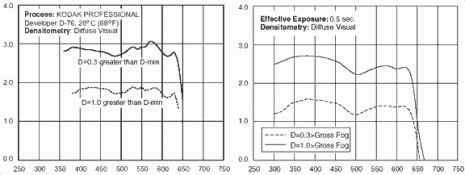"...the (TMY vs TX) response curve is also a lot more linear, like that of a digital capture device."
Harry, take a look at the Kodak curves for Tri-X and TMY2.
Developed normally in D-76, they are nearly identical.
How much are they different ? In a very high quality film lab,
normal variations from run-to-run would make their results identical.
How do they differ ?
The Tri-X shoulder begins beyond the white threshold of Ilford FB papers, and TMY2 begins less than one f/stop further.
Darkroom Legend #1: Tri-X is more forgiving.
If I over develop Tri-X by a two minutes, I get printable negative if I use some soft developer and do some split-filter printing. A two minute mistake in TMY2 only wants a softer filter to print the highlights. TMY2 is more forgiving than Tri-X because it changes its curve shape less than Tri-X.
When I looked at my first roll of TMY, some 25 years ago, I thought, "Gosh, this does NOT look like Tri-X !"
Times being what they were, I couldn't blame it on digital. Instead I took a walk down to my 'local', and ran into a couple photographers I knew and we talked about it. We were all shooting TMY in plain yellow boxes; they were official Kodak beta shooters, I got mine from a guy I printed for.
"Yeah", they said, "this TMY stuff acts like it's Verichrome Pan, or something". Two pints of good beer later, it didn't really seem like a bad thing. Look at the MTF charts in the first post. Even though the film curve of TMY is similar to Tri-X (in D-76), its MTF is more like Verichrome Pan: lower granularity, higher acutance, and higher definition than Tri-X.
THAT is why TMY looks different than Tri-X. Or in my world, why 35mm TMY looks like 120 Tri-X. Again, not a bad thing.
The T-Grain substitute for Tri-X is NOT TMY2, it is TMZ.
•••••••••••••••••••••••••••••••••••••••••••••••••••••••••
"The response curve is also a lot more linear, like that of a digital capture device."
The best 'digital capture device' has a dynamic range of 10 EV. Tri-X in D-76 is still linear at 11 EV. So, Tri-X has a longer, linear scale than digital. So does FP4 and Plus-X. And so does TMY2.
None of this is meant to be contentious. I just set out to share some of the Kodak data that disproves numerous Internet Era Errors, and to be encouraging to photographers in a panic over the pending loss of a good, old film TXP.
While good, hard data seems to be absent from most photo conversation in our forum, and all the others, misinformation and error spreads like the flu. THAT is probably a greater danger to traditional photography than digital, a poor economy, or corporate self-interest.
Have fun today, the sun is shining and I'm going to shoot some snow pix.
.












